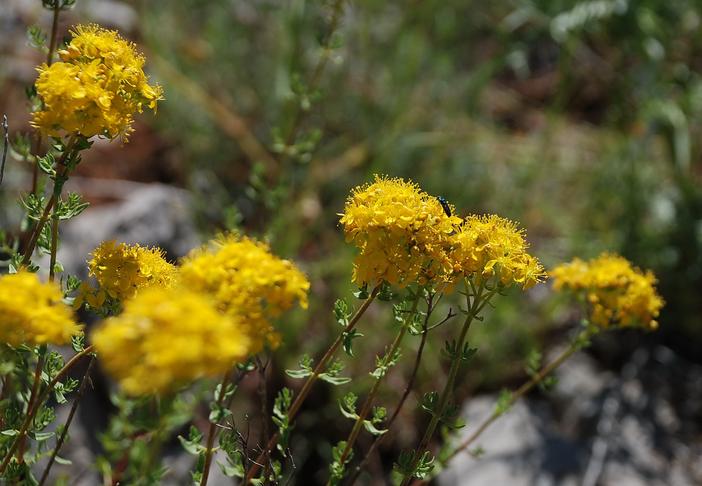Tutsan
(Hypericum scabrum)
Tutsan (Hypericum scabrum)
/
/

עוזי פז
CC BY 2.5
Image By:
עוזי פז
Recorded By:
Copyright:
CC BY 2.5
Copyright Notice:
Photo by: עוזי פז | License Type: CC BY 2.5 | License URL: https://creativecommons.org/licenses/by/2.5 | Uploader: Pikiwikisrael | Publisher: Wikipedia Commons





















Estimated Native Range
Summary
Hypericum scabrum, commonly known as Tutsan, is a perennial herb that thrives in a variety of habitats including open woodlands, grasslands, and rocky slopes across Europe, Asia, and the Middle East. It exhibits a moderate growth rate, achieving heights and widths of 1-3 feet (0.3-0.9 meters). The plant is characterized by its upright stems and dark green, ovate leaves. During the summer, Tutsan produces an abundance of yellow, star-shaped flowers that are quite showy and attract pollinators. The flowers may be followed by red to purple berries that add ornamental interest.
Tutsan is valued for its medicinal properties, as well as its ornamental appeal due to its bright flowers and berries. It is used in traditional medicine for its purported anti-inflammatory and antimicrobial effects. In gardens, it is often utilized in borders, as ground cover, or in naturalized areas. For optimal growth, Tutsan requires full sun to part shade and prefers medium or fast-draining soils, such as clay, loam, or sandy types, with consistent moisture. While it is generally easy to maintain, it can be susceptible to rust and leaf spot diseases. Gardeners should be cautious about its potential invasiveness outside its native range, as it can spread aggressively in some conditions.CC BY-SA 4.0
Tutsan is valued for its medicinal properties, as well as its ornamental appeal due to its bright flowers and berries. It is used in traditional medicine for its purported anti-inflammatory and antimicrobial effects. In gardens, it is often utilized in borders, as ground cover, or in naturalized areas. For optimal growth, Tutsan requires full sun to part shade and prefers medium or fast-draining soils, such as clay, loam, or sandy types, with consistent moisture. While it is generally easy to maintain, it can be susceptible to rust and leaf spot diseases. Gardeners should be cautious about its potential invasiveness outside its native range, as it can spread aggressively in some conditions.CC BY-SA 4.0
Plant Description
- Plant Type: Herb
- Height: 1-3 feet
- Width: 1-3 feet
- Growth Rate: Moderate
- Flower Color: Yellow
- Flowering Season: Summer
- Leaf Retention: Deciduous
Growth Requirements
- Sun: Full Sun, Part Shade
- Water: Medium
- Drainage: Medium, Fast
Common Uses
Bee Garden, Border Plant, Low Maintenance
Natural Habitat
Native to open woodlands, grasslands, and rocky slopes across Europe, Asia, and the Middle East
Other Names
Common Names: Hypericum, Aaron’s Beard
Scientific Names: , Hypericum scabrum, Drosanthe hyssopifolia, Drosanthe scabra, Hypericum asperum, Hypericum bourgaei, Hypericum cymosum, Hypericum galiiforme, Hypericum galioides, Hypericum scabrum subsp. citrinum
GBIF Accepted Name: